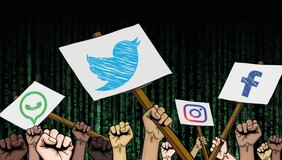Conspiracy theories in the digital age
By Tom Sandall
Conspiracy theories were common parlance in western political discourse, regarded as a legitimate form of knowledge until the 1950s. Perhaps the most widely accepted during this time were conspiracies suggesting that members of the Jewish community were pulling the strings In the background. As we all know, such conspiracies ultimately lead to their horrific persecution under the Nazi regime. Churchill was one such believer; in a speech he gave in 1920, he described three types of Jews, National, Zionist and international. He viewed this third type as leading a "worldwide conspiracy", believing that they were a threat to the global order and had been doing so since at least 1776 when the order of the Illuminati was first founded. Conspiracy theories have continued to exist; however, after the 1950s, they were regarded as illegitimate as they did not hold up to media scrutiny, so public figures who generated such ideas were disregarded. That is until recently, according to Michael Butter, Conspiracy theories now are "simultaneously legitimate and illegitimate knowledge" a large part of this is due to the way we consume media in the modern digital age.
Broadly speaking, conspiracy theories suggest that a group of individuals operate behind the scenes for nefarious means or are otherwise seeking to do so. The Political scientist Michael Barkun highlights three assumptions that underlie conspiratorial thinking: that nothing happens by accident, nothing is as it seems, and everything is connected. Because believers of conspiracy theories have these assumptions, most conspiracy theories are political. Individuals theorising about grand conspiracies have not changed because of the internet; it has increased the accessibility of narratives that confirm their pre-existing beliefs. The algorithms that underpin social media and search engines further contribute to this as they have generated filter bubbles and echo chambers. Conspiratorial media can now be produced at a low cost and reach a wider audience than ever before.
Nowadays, anyone with internet access and an inexpensive phone can now create a post on social media or upload a video to TikTok or YouTube with the potential to reach a viewership of millions. Conspiracy theories are also unfortunately still rife with antisemitism as the texts of old can now be accessed online in PDF format and built upon in the modern era. For example, the web documentary Loose Change suggest that the events of 9/11 was a false flag operation designed to create the political rhetoric necessary to invade Afghanistan. The initial version was produced at the low cost of $2,000 and was comprised of news clips spliced together with a simple voice over to explain the theory. The Second edition cost a higher $6,000 and received 10million views on Google Video, a precursor to YouTube. Its third edition featured Alex Jones, perhaps the widest know conspiracy theorist in the modern age, who runs a successful conspiracy empire with his Infowars site bringing in $20 million in 2014.
Not only does the internet widen the scope for conspiracy theories to be dispersed, but it also allows followers of such theories to form online groups to discuss said theories. In recent times, mainstream social media companies have taken steps to curtail the spread of information. However, those with such conspiratorial beliefs can migrate to another form to discuss their theories. Conspiracies will continue to straddle as legitimate to some, stigmatised to others in a position of limbo, so they remain an issue within contemporary politics. Conspiracy theories in the US are particularly problematic, and Donald Trump played a significant role in raising their legitimacy, which I will discuss in my subsequent post Mass Insurrection and Q.
Both this post and the next draw heavily influence from: Butter, M. (2020). The Nature of Conspiracy Theories. Translated by S. Howe. Cambridge, Uk ; Medford, Ma: Polity Press.


